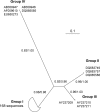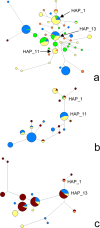Phylogenetic approach to the variability of the microsporidian Enterocytozoon bieneusi and its implications for inter- and intrahost transmission
- PMID: 20228101
- PMCID: PMC2869117
- DOI: 10.1128/AEM.03026-09
Phylogenetic approach to the variability of the microsporidian Enterocytozoon bieneusi and its implications for inter- and intrahost transmission
Abstract
Enterocytozoon bieneusi is a microsporidian parasite that infects many vertebrate animals, including humans. The rDNA internal transcribed spacer (ITS) shows a hypervariable sequence; however, so far no clear information has been inferred about strain evolution in this species. We reviewed all the sequences described and performed a phylogenetic study. Four groups of sequences strongly differentiated from each other were detected, although most of the isolates (94%) corresponded to group I. The highly diverse sequences of this group were analyzed using median-joining networks. The host species (humans, pets, swine, cattle, birds, and wild animals) and the continents of origin of the isolates were considered. Central haplotypes in the network were obtained from very diverse hosts and geographical origins. The results show that although E. bieneusi has a broad host specificity, transmission is not completely free: some strains were able to circulate within a given host species and were only occasionally transmitted to another host. Additionally, while not relevant for swine or cattle hosts, geography seems to be a relevant factor for human infection by E. bieneusi.
Figures



References
-
- Abe, N., I. Kimata, and M. Iseki. 2009. Molecular evidence of Enterocytozoon bieneusi in Japan. J. Vet. Med. Sci. 71:217-219. - PubMed
-
- Adl, S. M., A. G. Simpson, M. A. Farmer, R. A. Andersen, O. R. Anderson, J. R. Barta, S. S. Bowser, G. Brugerolle, R. A. Fensome, S. Fredericq, T. Y. James, S. Karpov, P. Kugrens, J. Krug, C. E. Lane, L. A. Lewis, J. Lodge, D. H. Lynn, D. G. Mann, R. M. McCourt, L. Mendoza, O. Moestrup, S. E. Mozley-Standridge, T. A. Nerad, C. A. Shearer, A. V. Smirnov, F. W. Spiegel, and M. F. Taylor. 2005. The new higher level classification of eukaryotes with emphasis on the taxonomy of protists. J. Eukaryot. Microbiol. 52:399-451. - PubMed
-
- Bandelt, H. J., P. Forster, and A. Röhl. 1999. Median-joining networks for inferring intraspecific phylogenies. Mol. Biol. Evol. 16:37-48. - PubMed
-
- Bornay-Llinares, F. J., A. J. da Silva, H. Moura, D. A. Schwartz, G. S. Visvesvara, N. J. Pieniazek, A. Cruz-López, P. Hernández-Jauregui, J. Guerrero, and F. J. Enríquez. 1998. Immunologic, microscopic, and molecular evidence of Encephalitozoon intestinalis (Septata intestinalis) infection in mammals other than humans. J. Infect. Dis. 178:820-826. - PubMed
-
- Breitenmoser, A. C., A. Mathis, E. Bürgi, R. Weber, and P. Deplazes. 1999. High prevalence of Enterocytozoon bieneusi in swine with four genotypes that differ from those identified in humans. Parasitology 118:447-453. - PubMed
MeSH terms
Substances
LinkOut - more resources
Full Text Sources

